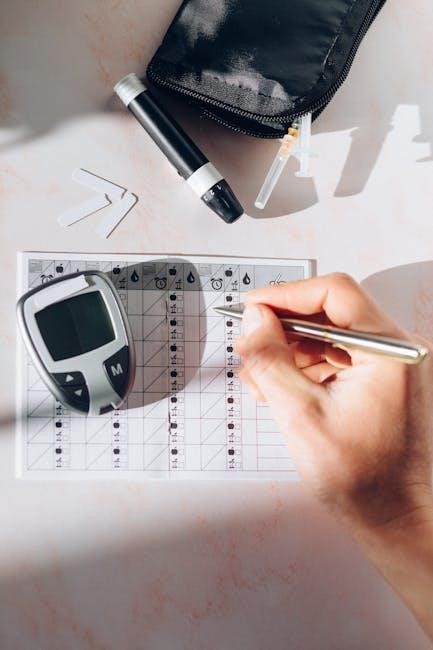A medical coding cheat sheet PDF serves as a quick reference guide, offering essential ICD-10-CM, CPT, and HCPCS codes, along with modifiers and guidelines for accurate billing.
What is a Medical Coding Cheat Sheet?
A medical coding cheat sheet is a concise reference guide designed to help healthcare professionals quickly access essential coding information. It typically includes commonly used ICD-10-CM, CPT, and HCPCS codes, along with modifiers and coding guidelines. These sheets are often available as printable PDFs, making them easy to use in daily practice. They serve as a time-saving tool for medical coders and billers, ensuring accuracy and efficiency in the billing process. By organizing complex coding details into a simplified format, cheat sheets streamline workflows and reduce errors, making them an invaluable resource for both novice and experienced coders.
Importance of a Medical Coding Cheat Sheet
A medical coding cheat sheet is an indispensable tool for healthcare professionals, ensuring accurate and efficient coding. By providing quick access to essential ICD-10-CM, CPT, and HCPCS codes, along with modifiers and guidelines, it streamlines the billing process. This resource reduces errors and saves time, especially for complex or frequently used codes. It also helps maintain compliance with coding standards, minimizing the risk of rejected claims. For both novice and experienced coders, a cheat sheet serves as a reliable reference, enhancing productivity and ensuring accurate reimbursements. Its portability and ease of use make it a vital asset in modern medical billing workflows.
Benefits of Using a Medical Coding Cheat Sheet
Using a medical coding cheat sheet offers numerous benefits, enhancing efficiency and accuracy in billing processes. It provides quick access to essential codes, modifiers, and guidelines, reducing errors and saving time. The cheat sheet simplifies complex coding scenarios, ensuring compliance with industry standards. Customizable options allow users to tailor content to their specific needs, while regular updates keep the information relevant. This tool is particularly valuable for new coders, serving as a learning aid, and for experienced professionals, acting as a reliable reference. By streamlining workflows and improving precision, a medical coding cheat sheet is an indispensable resource for healthcare providers and billers alike.

Understanding ICD-10-CM Codes
ICD-10-CM codes are a standardized system for classifying diseases and health conditions, offering enhanced specificity and structure compared to earlier versions. They play a critical role in accurate billing and insurance claims, ensuring detailed documentation of patient diagnoses. The cheat sheet provides a concise guide to understanding these codes, making it easier for coders to navigate the complexities of the ICD-10-CM coding system effectively.
Overview of ICD-10-CM Coding System
The ICD-10-CM (International Classification of Diseases, 10th Revision, Clinical Modification) is a standardized system used for classifying diseases, symptoms, and medical conditions. It provides a detailed framework for coding diagnoses, with codes structured as alphanumeric combinations up to seven characters long. The system enhances specificity and accuracy compared to its predecessor, ICD-9-CM, allowing for better tracking of health conditions and outcomes. A medical coding cheat sheet often includes guidelines and examples for applying ICD-10-CM codes, ensuring coders can quickly reference key information and maintain compliance with coding standards. This system is essential for accurate billing, insurance claims, and healthcare data analysis.
Key Features of ICD-10-CM Codes
ICD-10-CM codes are highly detailed, with a structure that includes up to seven alphanumeric characters, allowing for greater specificity in coding. They incorporate laterality (e.g., left or right side) and provide combinations for multiple conditions or manifestations. The system also includes expanded code sets for mental, behavioral, and neurodevelopmental disorders, as well as external causes of injury. A medical coding cheat sheet often highlights these features, enabling coders to quickly identify the correct codes. The enhanced specificity improves data collection, reduces coding errors, and supports precise tracking of diseases and health trends, making it a vital tool for accurate medical billing and reporting.
Common ICD-10-CM Codes and Their Applications
Common ICD-10-CM codes include Z00.00 for routine health exams, R05 for cough, and I10 for essential hypertension. These codes are frequently used in medical billing for everyday diagnoses. For example, M54.5 is used for lower back pain, while F41.1 represents generalized anxiety disorder. A medical coding cheat sheet often lists these codes, making it easier for coders to reference them quickly. They cover a wide range of conditions, from acute illnesses to chronic diseases, ensuring accurate and efficient coding. These codes are essential for healthcare providers to document patient conditions and streamline the billing process effectively.

Exploring CPT Codes
CPT (Current Procedural Terminology) codes are standardized codes used to describe medical, surgical, and diagnostic services. They are essential for accurate billing and insurance claims.
CPT, or Current Procedural Terminology, is a standardized system of codes used to describe medical, surgical, and diagnostic procedures and services. Maintained by the American Medical Association (AMA), CPT codes are essential for billing and insurance claims, ensuring consistent communication among healthcare providers, payers, and patients. Each code represents a specific procedure, such as office visits, surgeries, or lab tests, and is structured as a numeric code with up to five digits. A CPT cheat sheet provides quick access to commonly used codes, helping coders streamline the billing process and ensure accuracy. It’s a vital tool for efficient and precise medical coding.
Structure and Organization of CPT Codes
CPT codes are organized into three main categories: medical, surgical, and diagnostic services. Codes are numeric, ranging from 00000 to 99999, with each code representing a specific procedure or service. The structure includes six levels of specificity, allowing precise documentation. For example, codes for office visits (99201-99215) are distinct from surgical procedures (10000-69999). A CPT cheat sheet simplifies navigation by grouping codes into common sections, such as evaluation and management or radiology. This organization helps coders quickly locate relevant codes, ensuring accurate and efficient billing. Regular updates to CPT codes reflect advancements in medical practices and technologies.
Examples of Common CPT Codes
Common CPT codes include 99213 for office visits, 96372 for therapeutic injections, and 71045 for chest X-rays. These codes are frequently used in medical billing and are often highlighted in cheat sheets for quick reference. For instance, 99213 is a standard code for established patient office visits, while 96372 applies to intramuscular injections. Radiology codes like 71045 are essential for imaging services. Cheat sheets organize these codes by category, such as evaluation and management, surgical, or diagnostic services, making it easier for coders to identify and apply the correct codes. This streamlines the billing process and reduces errors in medical coding.

HCPCS Codes and Modifiers
HCPCS codes cover medical supplies, medications, and non-physician services, while modifiers like -25 or -59 provide context. Cheat sheets simplify their use, ensuring accurate billing and compliance.

Understanding HCPCS Level II Codes
HCPCS Level II codes are essential for billing non-physician services, medical supplies, and equipment. These codes, maintained by CMS, are updated annually to reflect current medical practices. They consist of alphanumeric codes, with the first character indicating the category (e.g., A for transportation, E for durable medical equipment). Coders use these codes to bill for items like wheelchairs, prosthetics, and injectable medications. The cheat sheet PDF often includes common HCPCS codes, such as A0021 for ambulance services or E0110 for wheelchairs, ensuring accurate and efficient billing. Understanding these codes is crucial for compliance and proper reimbursement in healthcare settings.
Role of Modifiers in Medical Coding
Modifiers play a crucial role in medical coding by providing additional context to procedures and services. They are alphanumeric codes appended to CPT or HCPCS Level II codes to clarify or modify the service billed. For example, modifier 25 indicates a separate procedure, while 59 denotes a distinct procedural service. Modifiers like -LT (left side) or -RT (right side) specify laterality. They prevent payment reductions and ensure accurate claims by explaining exceptions or special circumstances. A cheat sheet PDF often lists common modifiers, their definitions, and usage guidelines, helping coders apply them correctly and maintain compliance with billing standards. Proper use of modifiers is essential for efficient and accurate reimbursement processes.
Common HCPCS Codes and Modifiers
HCPCS (Level II) codes are used to report supplies, medications, and non-physician services. Common codes include Q0091 for influenza vaccines and J1094 for testosterone injections. Modifiers like EY (upper eyelid) and F1 (bioelectrical) provide additional context. These codes and modifiers are essential for accurate billing in medical coding. A cheat sheet PDF often lists frequently used codes and modifiers, such as A0021 for ambulance mileage and GP for telehealth services. They help prevent payment issues and ensure compliance with billing standards. By referencing a cheat sheet, coders can quickly identify the correct codes and modifiers for specific services, enhancing efficiency and accuracy in the billing process.

Medical Coding Guidelines and Conventions
Medical coding guidelines and conventions ensure accurate and compliant coding. These include rules for ICD-10-CM, CPT, and HCPCS, such as proper sequencing, laterality, and modifier usage. A cheat sheet PDF summarizes these rules and provides examples for quick reference, helping coders maintain efficiency and reduce errors in billing and reporting.
Official Guidelines for Coding and Reporting
Official guidelines for coding and reporting are foundational for accurate medical coding. These rules, published by CMS and updated annually, provide detailed instructions for ICD-10-CM, CPT, and HCPCS Level II codes. They cover code selection, sequencing, and modifiers, ensuring compliance with regulatory standards. The guidelines address specific scenarios, such as laterality, unspecified codes, and bundling, to prevent errors. Staying updated with these guidelines is crucial for coders to maintain compliance and avoid reimbursement issues. A medical coding cheat sheet PDF often includes summaries of these guidelines, making them easily accessible for quick reference during the coding process.
Important Coding Conventions
Important coding conventions ensure consistency and accuracy in medical coding. These rules, often summarized in a medical coding cheat sheet PDF, cover essential practices like code sequencing, laterality, and the use of placeholder X codes in ICD-10-CM. Conventions also address when to use unspecified codes and how to handle bundling or unlisted procedures in CPT. Additionally, they provide guidance on modifiers, such as 26 for professional components or 50 for bilateral procedures. Adhering to these conventions helps coders avoid errors and ensure compliance with payer guidelines. Regular updates to these conventions are critical, as coding standards evolve over time. They are a cornerstone of accurate and efficient coding practices.

Examples of Coding Scenarios
Medical coding cheat sheets often include real-world examples to illustrate coding scenarios. For instance, an office visit for an established patient might use CPT code 99213, while a preventive care visit could use 99417. Diagnosis coding examples include Z00.01 for a routine adult exam or I10 for essential hypertension. These examples help coders understand how to apply codes in specific situations. Scenario-based examples also cover procedures like injections (CPT 96372) or lab tests (CPT 80053). Such examples, paired with their corresponding codes, provide practical guidance, ensuring accurate and efficient coding. They are invaluable for training and everyday reference, enhancing coding precision and compliance.

Customizing Your Medical Coding Cheat Sheet
Tailor your cheat sheet by including frequently used codes, specific modifiers, and relevant guidelines. Add personal notes for quick reference and enhanced usability and efficiency.
How to Create a Personalized Cheat Sheet
To create a personalized medical coding cheat sheet, start by identifying frequently used codes specific to your practice or specialty. Organize the codes by category, such as ICD-10-CM, CPT, or HCPCS, for easy access. Include modifiers and relevant guidelines to ensure accuracy. Add notes or tips based on common coding scenarios or challenges. Use a clean, readable format and highlight important sections for quick reference. Regularly update the cheat sheet to reflect coding changes or new guidelines. Customize the layout and content to suit your workflow, making it a valuable tool for efficient and accurate coding.
Downloading and Printing the Cheat Sheet
To download a medical coding cheat sheet PDF, visit trusted sources like official medical coding websites or platforms offering free templates. Search for “free medical coding cheat sheet PDF” to find downloadable options. Once downloaded, review the content to ensure it includes essential codes, modifiers, and guidelines. Print the cheat sheet on high-quality paper for clear visibility. Consider laminating it for durability and ease of use. Consider customizing the layout or adding notes before printing. Regularly check for updates to ensure the information remains current and compliant with coding standards. A well-organized, printed cheat sheet can be a indispensable resource for daily coding tasks.
Tips for Regular Updates and Relevance
Tips for Regular Updates and Relevance
To keep your medical coding cheat sheet relevant, regularly check for updates from official sources like CMS.gov or the AMA. Subscribe to newsletters or follow coding organizations for the latest changes. Review and update your cheat sheet quarterly to reflect new codes, modifiers, or guidelines. Utilize online forums and coding communities to stay informed about industry trends. Cross-reference with the latest ICD-10-CM and CPT codebooks to ensure accuracy. Highlight or note any changes in the PDF before printing. Finally, incorporate feedback from colleagues or mentors to refine your cheat sheet and ensure it remains a practical, up-to-date resource for your coding needs.

Best Practices for Using a Medical Coding Cheat Sheet
Always reference official guidelines and codebooks to ensure accuracy. Regularly review and update your cheat sheet with the latest codes and modifiers from CMS or AMA sources.
Maximizing Efficiency with the Cheat Sheet
A well-organized medical coding cheat sheet ensures quick access to essential codes and guidelines, streamlining the coding process. By referencing the cheat sheet during daily tasks, coders can reduce errors and save time. Regular updates keep the document relevant, while customization allows tailoring to specific practices or specialties. Prioritize commonly used codes and modifiers for faster lookup. Use clear headings and sections to enhance readability. Cross-referencing with official coding guidelines ensures compliance and accuracy. Incorporate tips for complex scenarios to handle challenging cases efficiently. Regular reviews and updates maintain the cheat sheet’s effectiveness, making it an indispensable tool for coders seeking to optimize their workflow and productivity.
Ensuring Accuracy in Coding
Accuracy in medical coding is critical for proper patient care and reimbursement. A cheat sheet simplifies this by providing clear, organized access to essential codes and guidelines. Always cross-reference codes with official sources to confirm validity. Pay attention to modifiers, as they alter code meanings and ensure precise billing. Familiarize yourself with common coding errors, such as incorrect code sequencing or overlooked modifiers. Regular updates ensure compliance with the latest coding standards. Use the cheat sheet to quickly verify complex scenarios, like infusion therapies or cardiovascular procedures. Clear organization and concise information help reduce mistakes, ensuring accurate and compliant coding outcomes consistently.
Staying Updated with Coding Changes
Medical coding is constantly evolving, with updates to ICD-10-CM, CPT, and HCPCS codes annually. Staying informed is crucial for accuracy and compliance. Utilize a medical coding cheat sheet PDF to access the latest changes quickly. Regularly check official sources like CMS.gov for Medicare updates and the AMA website for CPT revisions. Subscribe to coding newsletters and attend webinars to stay current. Incorporate new codes, such as ICD-10 updates for emerging conditions or HCPCS codes for new injectables, into your cheat sheet. Update your cheat sheet semi-annually to reflect these changes. This ensures your reference remains relevant and reliable for everyday use.
A medical coding cheat sheet PDF is a vital resource for efficient, accurate, and compliant coding. Regular updates ensure relevance, helping coders stay ahead of industry changes.
Final Thoughts on Medical Coding Cheat Sheets
A medical coding cheat sheet PDF is an indispensable tool for coders, offering a concise yet comprehensive reference for ICD-10-CM, CPT, and HCPCS codes. By providing essential guidelines, modifiers, and examples, it streamlines the coding process, reduces errors, and enhances efficiency. Customizable and easily accessible, these cheat sheets empower professionals to stay updated with coding changes and industry standards. Regular updates ensure relevance, making them a valuable resource for both novice and experienced coders. Ultimately, a well-organized medical coding cheat sheet is a cornerstone for accurate, compliant, and effective coding practices in healthcare settings.

Encouragement to Utilize the Cheat Sheet
Embrace the convenience of a medical coding cheat sheet PDF to enhance your coding accuracy and efficiency. This invaluable resource simplifies complex coding processes, ensuring compliance with industry standards. By downloading and customizing your cheat sheet, you gain quick access to essential codes, modifiers, and guidelines. Regular updates keep you informed about the latest changes, helping you stay ahead in the field. Whether you’re a seasoned coder or just starting out, this tool is designed to save time and reduce errors. Make it a staple in your workflow to streamline your coding tasks and achieve optimal results consistently.



